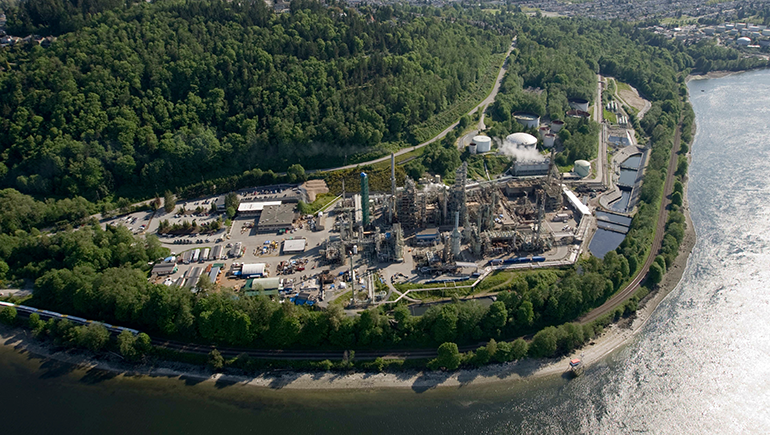Industrial land shortage leads to lost jobs, opportunities
At a glance (4 minute read)
- Industrial land shortage in Metro Vancouver has caused skyrocketing prices, tripling land costs over five years, leading to a loss of 6,300 jobs, $4.77 million in wages, and $494 million in GDP.
- Industrial land vacancy rates are now at one per cent, and costs per acre are six times higher in the region compared to Metro Seattle or Calgary.
- Increasing industrial land availability in Metro Vancouver by just one per cent could create an additional 126,100 jobs and generate $12.2 billion in GDP for British Columbia.

In the last 4.5 years, the shortage of industrial land in Metro Vancouver has led to:
- skyrocketing prices, with average land costs tripling over the last five years; and
- a loss of 6,300 jobs, $4.77 million in wages and $494 million in GDP.
Per acre, average costs are now six times higher in our region compared to Metro Seattle or Calgary, impeding investment, growth, and innovation, according to a study commissioned by the Greater Vancouver Board of Trade (GVBOT) and the National Association of Industrial and Office Parks (NAIOP).
“Industrial lands continue to be the backbone of our economy, comprising just four per cent of Metro Vancouver's area while contributing a third of local jobs and over $50 billion in GDP annually,” said Bridgitte Anderson, GVBOT president and CEO.
Study highlights
The study by InterVISTAS found that:
- industrial land vacancy rates are now 1 per cent, among the lowest in North America;
- average costs per acre are now six times higher in our region than in Metro Seattle or Calgary; and
- over the past 4.5 years, 5.1 million sq. ft. of space has been taken up by firms in Calgary rather than Metro Vancouver.
Industrial lands make up just four per cent of the total land mass in Metro Vancouver, but generate:
- more than one in four jobs or 527,100 direct and indirect jobs;
- one third of regional GDP or $50.1 billion in GDP; and
- an output of $92.5 billion into the regional economy.
If Metro Vancouver had just one per cent more industrial lands
For every one per cent increase in land available for jobs and production, the study estimates:
- an additional 126,100 jobs are created; and
- $12.2 billion in GDP is generated for BC.
These jobs would provide above average salaries and would substantially increase local production, manufacturing, and support local industries.
The solution
The GVBOT and NAIOP Vancouver are recommending that municipalities, Metro Vancouver, and the provincial government:
- Re-focus regional land use planning to prioritize local – local housing, local food, and local production and jobs.
- Increase protection and availability of industrial land in Metro Vancouver from the current 4 per cent, including looking at non-productive lands that could be converted.
- Revise regional land use plans every three years and require enough supply of industrial and employment lands.
Work with the private sector
The GVBOT and NAIOP Vancouver are calling on governments to work with the private sector to address seven barriers to development:
- Mis-matched land use (industrial lands being used for non-industrial purposes such as residential).
- Red tape, high fees, and regulatory impediments.
- Long-term protection of industrial lands doesn’t cover all current lands in the inventory.
- Lands lacking access to key transportation corridors and infrastructure.
- Land parcels are too small for trade-enabling purposes.
- Better balance competing land use priorities.
- Inability to find larger footprint if businesses want to increase scale.
Metro Vancouver Industrial Lands Vacant Supply
Sub Regions |
Vacant Land hectares (acres) 2015 |
Vacant Land hectares (acres) 2020 |
Change in Vacant Land |
|---|---|---|---|
Burnaby/New Westminster |
77 (190) |
42 (104) |
-35 (-86) |
Delta/Tsawwassen First Nation |
326 (806) |
313 (773) |
-13 (-32) |
Langley |
193 (477) |
176 (435) |
-17 (-42) |
North Shore |
28 (69) |
21 (52) |
-7 (-17) |
Northeast sector |
36 (89) |
56 (138) |
20 (49) |
Richmond |
307 (759) |
271 (670) |
-36 (-89) |
Ridge – Meadows |
419 (1,035) |
593 (1,465) |
174 (430) |
Surrey/White Rock |
857 (2,118) |
616 (1,522) |
-241 (-596) |
Vancouver |
17 (42) |
27 (67) |
10 (25) |
Total |
2,260 (5,584) |
2,115 (5,226) |
-145 (-358) |
View the full report, Economic Impact Study of the Critical Shortage of Industrial Land in Metro Vancouver. (opens 47-page pdf)
If you have questions about this study, contact Harriet Permut, director of government relations at hpermut@rebgv.org. Harriet is a member of the GVBOT Regional and Civic Affairs Committee.